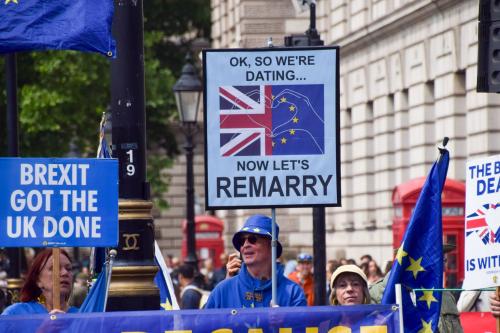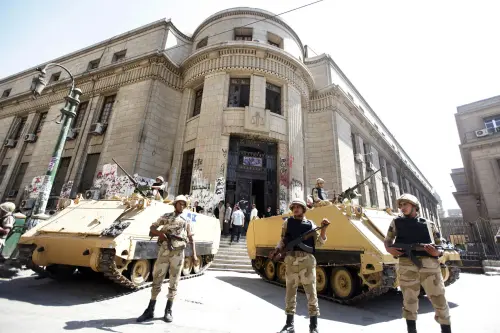The following is a summary of the 36th session of the Congressional Study Group on Foreign Relations and National Security, a program for congressional staff focused on critically engaging the legal and policy factors that define the role that Congress plays in various aspects of U.S. foreign relations and national security policy.
On August 16, 2024 the Congressional Study Group on Foreign Relations and National Security convened virtually to discuss threats to underseas telecommunications cables and strategies Congress may consider for protecting them. Our modern global telecommunications system is built in substantial part on massive networks of underseas cables that connect various corners of the world. These networks have never been more economically or politically important. Yet these cables are governed by an antiquated international legal framework, even as they are under new threats by state actors—including China and Russia—that seem increasingly intent on surreptitiously tapping into or even disrupting them in order to secure a strategic advantage over their rivals.
The study group was joined by three experts for this session:
- Jennifer Counter, vice president at Orbis Operations and a nonresident senior fellow in the Forward Defense practice at the Atlantic Council’s Scowcroft Center for Strategy and Security;
- Kevin Frazier, assistant professor at St. Thomas College of Law and a current Tarbell fellow at Lawfare; and
- Amy Paik, an incoming fellow at the Wilson Center, associate research fellow at the Korea Institute for Defense Analysis, and fellow at the John Hopkins University School of Advanced and International Studies.
Prior to the discussion, the study group circulated the following background readings:
- Kevin Frazier, “On Protecting the Undersea Cable System,” Lawfare (Jan. 12, 2023);
- Jill Gallagher and Nicole Carter, “Protection of Undersea Telecommunications Cables: Issues for Congress,” Congressional Research Service (Aug. 7, 2023);
- Amy Paik and Jennifer Counter, “International Law Doesn’t Adequately Protect Undersea Cables. That Must Change,” The Atlantic Council (Jan. 25, 2024); and
- “How to Protect Undersea Cables with Kevin Frazier,” Lawfare Daily (May 24, 2024) (podcast).
Paik began the discussion by emphasizing the critical role of undersea cables, noting that 95% of internet traffic and over ten trillion USD worth of financial transactions rely on these cables. She highlighted various case studies demonstrating the severe consequences of cable disruptions, such as the February 2023 Matsu Island blackout, which left 13,000 residents without power for 50 days after cables were damaged. Additionally, Paik discussed evidence that countries like Russia are investing in and testing submarine capabilities to sever cables in hard-to-detect locations, as illustrated by the 2019 Losharik incident, where a Norwegian cable was cut by the Russian Losharik vessel. While the Russian Defense Ministry claimed the cut was due to a fire on the vessel, other authorities suspect it was a deliberate act.
Paik explained that key provisions of the 1982 United Nations Convention on the Law of the Sea (UNCLOS) help define a legal framework for this issue. UNCLOS Article 87 ensures the freedom of the High Seas and grants all states the right to install submarine cables. Additionally, Article 113 requires states to enact laws to prevent the destruction of submarine cables but does not impose any affirmative obligation to protect them. Therefore, under UNCLOS, unless individual countries enact binding domestic laws to safeguard undersea cables, there is little hope for this international agreement to do so.
Paik raised that there is a gap in international law: What happens if a cable is physically damaged by an aggressor on the High Seas? Unless damage occurs in a country’s Exclusive Economic Zone (UNCLOS Article 57), it is impossible to hold an aggressor state or state-sponsored attacker accountable for an incident in the the High Seas, which is the core problem necessitating an international regulatory regime (Paik 2023). The crux of the issue is that if a cable is broken or damaged by an actor, the state under whose flag the ship operates or the actor’s state of citizenship has jurisdiction to address the injury. Therefore, Paik recommends that jurisdiction should be shared between the cable owner’s and attacker’s states to create a stronger deterrent. Knowing they may be more vulnerable to accountability in the cable owner’s court, potential perpetrators—likely from states with advanced submarines—might reconsider before attempting sabotage.
Counter then outlined the broader political landscape surrounding these issues. She noted that states adversarial to the United States do not approach such issues with the same level of review, scrutiny, and bureaucracy that is expected of American government today. Counter cited examples like the 2017 assassination attempt in North Korea using VX gas to show that adversaries are willing to take significant risks that the heavily regulated U.S. government would avoid. Thus, she argued that more creative thinking is necessary to protect cables.
Counter further explained that while cable cutting would indeed be a significant nuisance to the U.S. and Europe, which are well connected with redundant cables, smaller island nations and countries might experience a complete shutdown if even a single line is severed. If such a cut is not quickly repaired, it could lead to distrust in the government and potentially cause unrest. She argued that it is time to think seriously about how to protect cables—not just for our own purposes (e.g., maintaining internet access) but also to protect our allies and guard against threats from China, Russia, and Iran. A modern international agreement to prevent malicious activities would be a good starting point.
Frazier elaborated on congressional actions related to undersea cables. The 2022 Don Young Coast Guard Authorization Act acknowledges significant concerns about the damage caused by anchors dropped on cables and prohibits vessels from coming too close to undersea cables. However, this provision may be challenging to enforce in practice: As we continue to lay more cables, the risk of damage increases. Additionally, there is the Cable Ship Security Program, through which Congress has funded two privately owned U.S. ships tasked with repairing hundreds of cables that carry U.S. traffic. However, Frazier emphasized that as both the number of cables on the ocean floor and the capabilities to disrupt them increase, far more repair ships will be required.
Frazier also noted that penalties for disrupting a cable are outlined in the 1884 Convention on the Protection of Submarine Telegraph Cables. If an injury is intentional, the fine is $500; if caused by neglect, the fine may not exceed $500. These penalties are insufficient, as corporations are unlikely to be deterred by these relatively small fines.
Frazier proposed four basic solutions: (1) Increase funding for existing regulatory regimes, such as the Don Young Act, to better monitor where vessels are anchoring; (2) enhance congressional oversight to ensure that repair ships are equipped to succeed in their tasks and to spur increased investment in a cable repair fleet; (3) expand the scope and scale of the Cable Security Program; and (4) increase penalties for cable damage.
Next, Frazier suggested some more innovative solutions. The U.S. could establish a cable protection zone, designating areas where naval traffic is prohibited. This measure has been adopted by Australia and New Zealand, with more success in the latter due to its smaller number of cables. However, this solution may not be ideal for the U.S., which has many cables to protect. Alternatively, a viable solution could be to ensure that all future cables are laid in a specific zone, facilitating monitoring to prevent damage. Moreover, these cables could be hidden from anyone outside those involved in their installation and their respective governments, an idea promoted by former British Prime Minister Sunak. The tradeoff here is that if the cable locations are kept secret, there is no way to prevent players from mistakenly dropping anchors.
Frazier advanced that the best solution would be to lay smart cables equipped with sonar to detect breaks easily, to enhance our intelligence capabilities, and to expand our fleet of cable repair ships. Lastly, there must be a robust intelligence network focused on undersea cable protection that is consistently shared among American allies.
The study group then concluded with an open discussion session, during which attendees were free to comment on and pose questions regarding the various issues raised.
Visit the Congressional Study Group on Foreign Relations and National Security landing page to access notes and information on other sessions.
The Brookings Institution is committed to quality, independence, and impact.
We are supported by a diverse array of funders. In line with our values and policies, each Brookings publication represents the sole views of its author(s).



Commentary
Protecting Underseas Cables
August 17, 2024